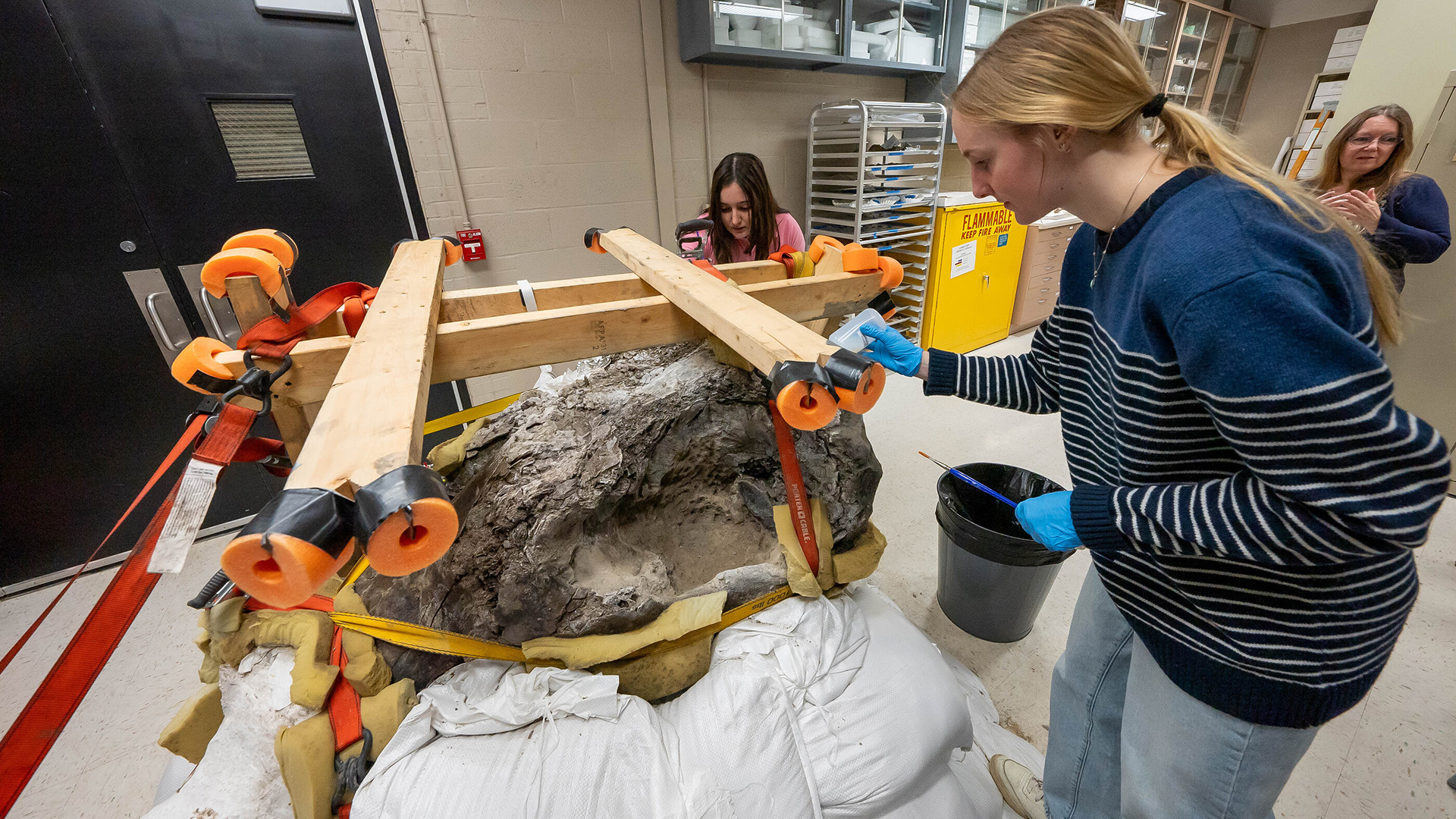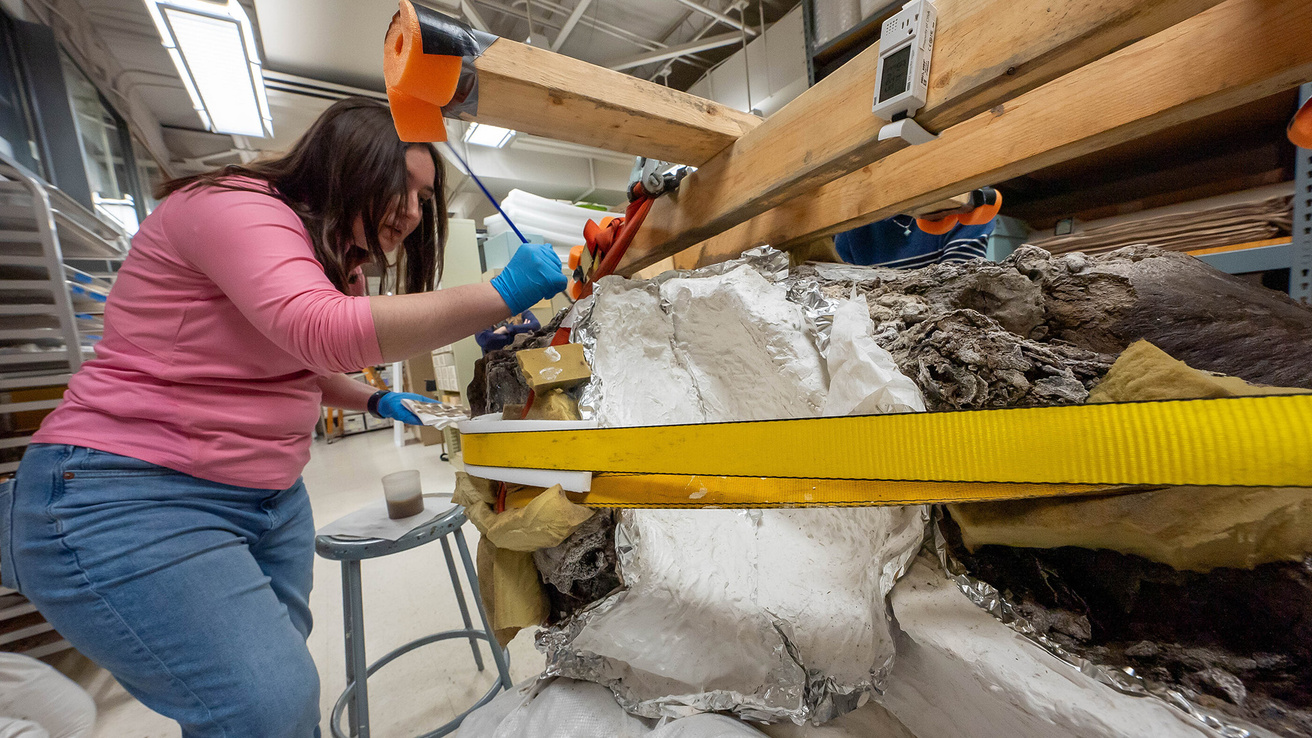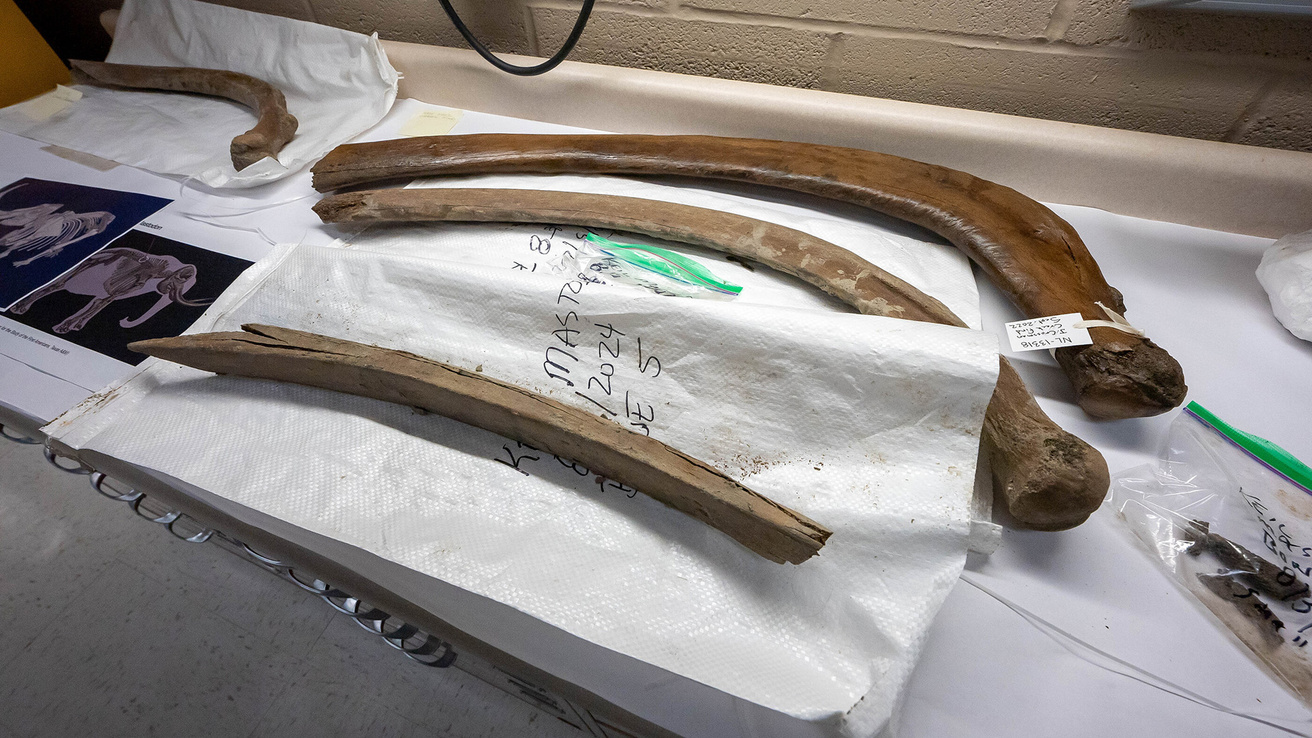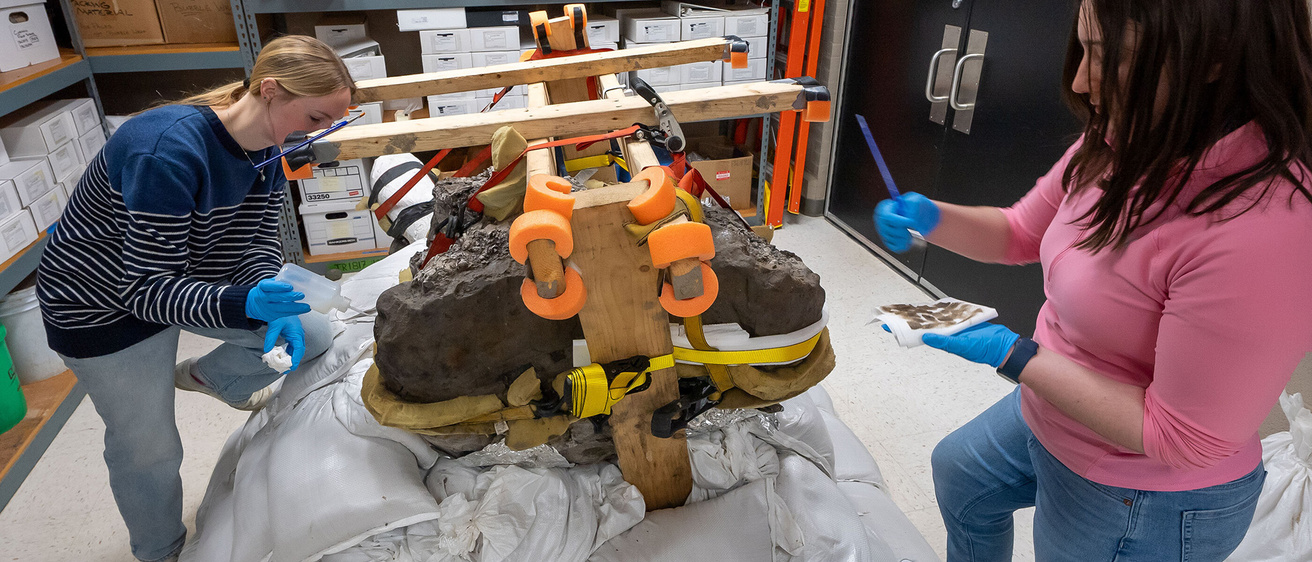Unprecedented find provides a unique opportunity for University of Iowa students to participate in the preservation of a piece of prehistory.
Story: Emily Nelson
Photography: Kirk Murray
Published: April 17, 2025
Maya Monk and Mary Haag have spent hours tucked into a back room at the Office of the State Archaeologist in Iowa City doing what Haag calls “reverse painting.”
The two University of Iowa undergraduate students are helping to carefully clean and preserve the skull and other bones of a mastodon excavated from Wayne County in summer 2024.
The students use small, soft paintbrushes and distilled water to slowly remove the dirt and clay that covers the mastodon skull, which sits within sandbags and a wooden frame to hold it in place. Along the way, Monk is consolidating the bones, applying an archival adhesive that seeps into the porous material to harden it and prevent further deterioration.
“It’s been such an incredible experience to get to work on this,” says Monk, a fourth-year student from Polk City, Iowa, working toward a BS in biology. “I’ve learned so much and had the chance to meet and work with so many amazing people.”
Mastodons, similar in appearance to elephants and mammoths, stood up to 10 feet tall and had long, curved tusks. The large mammals roamed North America from about 3.5 million years ago until 10,500 years ago. Radiocarbon dating determined that the mastodon the students are working on is 13,600 years old.
UI archaeologists and a group of community volunteers excavated the bones after the landowner discovered partially exposed bones in a creek bed in 2022. While mastodon bones are not rare in Iowa, it is unusual to find such a large collection of bones together in one place. And, more importantly, this is the first well-preserved skull to be scientifically excavated in Iowa.

Unearthing mastodon bones in southern Iowa
During a 12-day excavation in Wayne County, University of Iowa archaeology experts and community volunteers uncovered mastodon bones, including a nearly complete skull, and several human-made artifacts, such as stone tools.

“I had always been interested in archaeology and paleontology, especially when I was younger, so I thought I’d give it a try,” says UI student Maya Monk, seen in the foreground of this photo. “And then the mastodon project came up. I didn’t even know they could be found in Iowa. I thought it was so cool that I could work on such a rare project and maybe help discover things we didn’t know about them.”
The unprecedented find has provided a unique opportunity for undergraduate students to participate in the preservation of a piece of prehistory.
“There are not very many people who get to do this, even as a career,” says William Sprengelmeyer, a first-year student from Iowa City, Iowa. “It’s pretty crazy to have this sort of opportunity after only a couple months of college. It’s only my second semester, and I’m working with paleontologists and other experts in the field.”
Sprengelmeyer has helped with cleaning and consolidating the bones and now is leading the charge to 3D scan each one. The 3D models are being uploaded to a public site for researchers and the general public to use.
“It lets people observe the bones as in depth as possible without them having to travel or us having to ship them,” Sprengelmeyer says. “With a find as important as this one, you really don’t want to risk that if it can be avoided.”
“These students are getting to do something that most people probably never would.”
Tiffany Adrain, collections manager for the UI Paleontology Repository and adjunct instructor in the Department of Earth and Environmental Sciences, says the work wouldn’t get done without the students.
“We really value their assistance,” Adrain says. “Working with students — whether undergraduate, graduate, or high school — is one of the most rewarding parts of my job. I started volunteering and job shadowing when I was 15, so it’s important for me to provide that opportunity for other people because I had that and really benefited from it.”
Haag is a fourth-year student from Greendale, Wisconsin, working toward a BS in physics and astronomy and a certificate in museum studies. She had been working with the astronomical and atmospheric collection within the Paleontology Repository when Adrain brought up the mastodon project.
“I joke that this is my weird side quest,” says Haag, who now splits her time between the two projects. “When I say I’m working with meteorites, that makes sense with the astronomy degree, but when I tell friends I’m working on mastodon bones, they’re like, ‘What?’”
UI Paleontology Repository
With more than a million specimens, the University of Iowa Paleontology Repository is the fifth-largest university collection in North America. It offers invaluable insights into Earth’s ancient past, helping us to better understand the evolution of life, natural processes, and the origins of today’s ecosystems.
Haag plans to attend graduate school for space physics but says her work with the mastodon has been relevant to her education.
“It’s been a really good experience, and I’ve enjoyed the collaboration,” Haag says. “There is a lot of detail work in physics, and using and learning some of these different techniques could apply to my future career.”

UI undergraduate student Mary Haag, working toward a BS in physics and astronomy and a certificate in museum studies, learned about the mastodon project while working on an astronomical and atmospheric collection within the Paleontology Repository. “I joke that this is my weird side quest,” says Haag.
Monk says she started reaching out to faculty about potential research opportunities at the beginning of her junior year. Her advisor mentioned that Adrain was looking for help in the paleontology repository.
She started working on a digitization project of specimens in the Robert Wolf Collection, and shortly after received an Office of Undergraduate Research (OUR) Fellowship to work on the mastodon project.
“I had always been interested in archaeology and paleontology, especially when I was younger, so I thought I’d give it a try,” Monk says. “And then the mastodon project came up. I didn’t even know they could be found in Iowa. I thought it was so cool that I could work on such a rare project and maybe help discover things we didn’t know about them.”
Along with cleaning and consolidating the bones, Monk also has built foam and plaster supports for individual bones and helped monitor the condition of the bones as they dry.

When cleaning and preservation are complete, the mastodon bones will be displayed at the Prairie Trails Museum of Wayne County, not far from where they were discovered.
Despite being thousands of years old, the mastodon bones still aren’t old enough to have fossilized. This has created some challenges in removing the clay and dirt while preventing the bone from disintegrating. It’s estimated that it will take the skull about two years to fully dry out after its excavation.
Monk eventually wants to go to graduate school — likely in the areas of marine biology or marine conservation — but after graduation plans to work in conservation for a year or two to get experience and narrow down exactly what she wants to do.
While her work with the mastodon may not directly correlate with her future career, Monk says it’s been a valuable experience.
“It’s been fun to learn all the processes and techniques that a project like this requires,” Monk says.
Sprengelmeyer says he was an amateur fossil collector in high school. While taking a class in his first semester with Christopher Brochu, paleontologist and professor in the Department of Earth and Environmental Sciences, Sprengelmeyer asked Brochu if there might be fossil preparation tools available to him to use with his personal collection.
Brochu introduced him to Adrain, which led to Sprengelmeyer learning about and then starting to volunteer in the Paleontology Repository.
“I’m so grateful that this is such an open campus in terms of finding people who are willing to help and show you around, especially faculty and staff,” Sprengelmeyer says. “This all started with me asking, ‘Hey, do you know where I could get some tools?’ It’s a surreal thing going from high school picking up rocks near a pond to working with mastodon remains that made state headlines.”
Sprengelmeyer and John Doershuk, director and state archaeologist at the UI Office of the State Archaeologist, are applying for a summer OUR Research Fellowship to continue and expand Sprengelmeyer’s work — with the capital piece of the project being to 3D scan the mastodon skull.
“That will be my biggest challenge yet in scanning,” Sprengelmeyer says.
While he currently is majoring in biology, Sprengelmeyer says because of his work with the mastodon, he is seriously considering changing to something more focused on paleontology as well as a museum studies certificate.
“Biology has always been my favorite topic in the sciences, and I had in mind field biology as a career, going outside and physically being in nature and recording scientific data,” Sprengelmeyer says. “But I could see becoming a paleontologist at a dig site. There’s a lot of overlap between the two disciplines. Paleontology is just old biology. And my original plan would still be fulfilled.”
Adrain says it’s not unusual for students to tell her that their work with these projects helps their grades because they become more invested in their classes.
“Their classes often have some connection to what they’re doing,” Adrain says. “The fossils that they’re dealing with or the kind of work that they’re doing, they can apply something that they’ve learned about in class.”
In fall 2025, the departments of Geographical and Sustainability Sciences, and Earth and Environmental Sciences, along with the Environmental Sciences program, will constitute the new School of Earth, Environment, and Sustainability. Adrain says she expects this change to bring with it even more opportunities for students to get involved in exciting research.
Adrain says she never tires of seeing students’ excitement when working on projects such as the mastodon. And, even on a campus like Iowa that is filled with experiential learning opportunities, she says the mastodon project is rare.
“These students are getting to do something that most people probably never would.”
Cleaning, conserving, and learning from mastodon bones
After a 12-day excavation in southern Iowa in summer 2024, University of Iowa archaeologists transported multiple mastodon bones, including a nearly complete skull, to campus.
Tiffany Adrain, collections manager for the UI Paleontology Repository and adjunct instructor in the Department of Earth and Environmental Sciences, says the priority so far has been to get the bones cleaned and properly conserved.
Adrain says the UI team has been fortunate to have had the help of experts, including a preparator with the National Park Service at Badlands National Park and a self-employed preparator, who have visited to see the bones and offer advice.
“We wouldn’t be able to do this without that kind of expertise,” Adrain says.
Along with help from outside consultants, Adrain and her team also have received plenty of help from experts on campus. Among them were Matthew Wortel, a thin-section technician in the Department of Earth and Environmental Sciences. Wortel used portable X-ray fluorescence to determine the elemental composition of materials. Adrain says it was interesting for the team and students to see how it was done and what the results were.
Meanwhile, the 3D scanner that undergraduate student William Sprengelmeyer uses to generate images of the mastodon bones is on loan from Matthew Hill, professor and director of undergraduate studies in anthropology. The scanner was funded by Student Technology Fee funds, which are awarded to create, maintain and improve instructional technology resources.
“That’s the great thing about working at a university: We’ve got access to all this amazing expertise and equipment,” Adrain says.
Mastodons went extinct toward the end of the Ice Age, and their time in Iowa overlapped with the earliest evidence of humans in this part of the country.
“We’re really hoping to find evidence of human interaction with this creature — perhaps the projectile points and knives that were used to kill the animal and do initial butchering,” said John Doershuk, director and state archaeologist at the UI Office of the State Archaeologist, at the time of the excavation. “There’s also potential evidence on the bones themselves — there could be identifiable cut marks.”
While the team has not found such evidence so far, there are still bones covered in dirt and clay.
“We’re still in the preparation and conservation phase, but once everything is cleaned and stabilized, we’ll give everything a good going over and take another good look for cut marks,” Adrain says.
When cleaning and preservation are complete, the mastodon bones will be displayed at the Prairie Trails Museum of Wayne County, not far from where they were discovered. The museum, landowner, and state archaeologists agreed that the bones will be on loan for 10 years, with the option to renew every five years.
Adrain says they hope to have all the bones ready for the museum within two years. But, she says, she expects to start moving some bones to their new home this summer.
